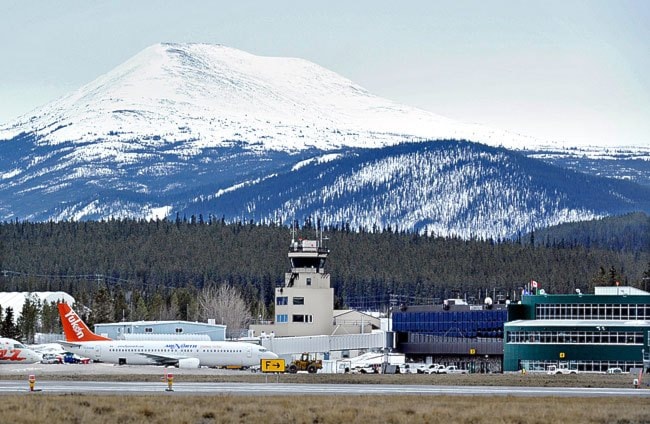A local contractor says the Yukon government knew about problems with the replacement of apron panels at the Whitehorse airport and chose to ignore them, a decision which could now cost millions to fix.
Doug Gonder, president of Norcope Construction Group, said his company was awarded a $3.5-million contract to build about 250 new concrete apron panels for the airport in 2014. The apron is the area where planes park and are unloaded. The 250 panels each measured about six metres by six metres, which would mean a total area of about 9,000 square metres.
But he said the government ordered the panels to be built without proper support underneath, and the concrete began to sink as soon as it was poured. Gonder said he raised concerns about the problem, but was told to keep doing what he was doing.
“They just ignored everything and kept building. It’s a real shame because this is a high-profile job that should have been delivered properly.”
Instead, he said, “we’ve got a failed project.”
On Thursday last week, NDP MLA Lois Moorcroft also placed blame at the government’s feet for the project’s problems.
“This same Yukon Party story has been repeated so many times that it is becoming the stuff of legend,” she told the legislature. “Inadequate contract management leads to repeated delays and do-overs.”
Public Works Minister Scott Kent responded that the contractor was responsible for the problems.
“The company that installed (the panels) will be responsible for replacing those,” he said.
“Obviously we feel that the contractor is responsible for those deficiencies, but work continues with them to develop a workplan and get the necessary repairs done to the apron panels,” he later added.
But Gonder said he’s absolutely not responsible, and he has the documentation to prove it.
The issue stems from a contract tendered in early 2014 for the removal and replacement of the existing apron panels. Norcope’s $3.5-million bid was the lowest the government received.
Kendra Black, a spokesperson for the Department of Highways and Public Works, said 85 per cent of the project was paid for by the federal government’s Airports Capital Assistance Program, with the remaining 15 per cent - approximately $525,000 - provided by the Yukon government.
Black said the work was completed during the summer of 2014, but would not comment on when deficiencies were first identified, how extensive they are, or how much they will cost to fix.
Gonder, however, gave a much more detailed version of events.
He said the root of the problem is that test holes drilled to sample the soil under the apron before the project was tendered only covered about a third of the apron. And they apparently missed some areas of seasonal permafrost close to the surface.
Gonder said that’s a problem because seasonal permafrost thaws and melts throughout the year, which will cause anything above it to sink and rise if it’s not reinforced.
He said the plan should have been to dig through that layer and put in a gravel base to support the concrete. Instead, he claims, he was instructed to build directly on top of that wet, silty soil. “They built on virgin ground with basically nothing supporting the apron.”
Gonder said as soon as Norcope started to work, it was clear they had big problems. He said the concrete started sinking right away, and sank by up to six inches in some places during the project.
Early in the summer, he called for the work to stop and met with government officials to discuss his concerns. He said he suggested they take out what they had already done and reinforce the base before building again.
But he says the government didn’t want to do that. He said he was told to keep working, but he was issued a letter from the government that appears to waive some of Norcope’s one-year liability for the project.
“Any cracking in the concrete panels will be investigated by both Norcope and the Government of Yukon. If the crack is shown to be caused by differential settlement, this will not be covered by Norcope’s one-year warranty,” reads the letter, dated June 11, 2014.
Gonder said that letter shows Norcope can’t be made to pay for any repairs.
“If the government is foolish enough to let somebody continue to build that project and then say it’s the contractor’s responsibility, boy, we’ve got a big problem with that.”
He said the concrete at the airport is already cracking, and he believes the entire project will need to be redone, which he believes will cost vastly more than what it would have cost to fix the problem early on.
“It probably would have been another $200,000 to fix it, and to do it properly, and now we’ve got a complete failed project because they tried to cheat and cut corners on building it.”
The government will not confirm the extent of the repairs that will be needed, though Moorcroft claims 13 panels have already been replaced since last year.
Since last Thursday, however, Kent’s response to the issue has changed. After further questions from Moorcroft in the legislative assembly on Tuesday, Kent no longer suggested the contractor was to blame. Instead, he simply repeated that the government is “in negotiations with the bonding company right now to determine how best to address those deficiencies.”
Black explained that the government holds a bond from Norcope worth half the value of the contract - roughly $1.75 million. She would not say any more about the negotiations.
This is not the first time Norcope and the Yukon government have locked horns.
In 2013, the two parties reached a confidential settlement in a contract dispute over sewage and piping the company had installed in the Whistle Bend subdivision.
Contact Maura Forrest at
maura.forrest@yukon-news.com
